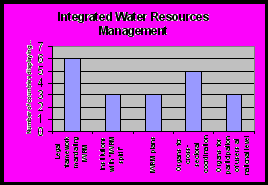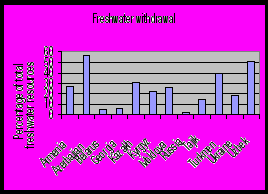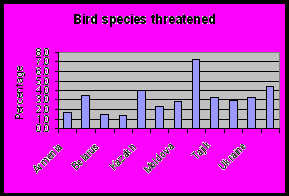Assessing Implementation of the eecca environmental Partnership Strategy – a baseline Report
| Вид материала | Документы |
- 1 моніторинг якості води результати хімічних аналізів, 168.04kb.
- Альянс медиа www allmedia, 37.91kb.
- Курс разработан на основе icb ipma competence Baseline. Version 0 Международной ассоциации, 41.45kb.
- Manual for the Design and Implementation of Recordkeeping Systems (dirks), 1279.81kb.
- Environmental Working Group (ewg) Яблоки возглавляют список, клубника на третьем, 45.95kb.
- Experience of tqm principles and iso 9000 implementation in the Pridneprovsky region, 67.13kb.
- Report of the Secretary-General on ip telephony, 249.71kb.
- 1 Report on activities carried out during the reporting period, 1773.42kb.
- *Сокращенный перевод кэкц. Опубликовано: Environmental values, 2006. V. 15,, 167.96kb.
- Physics Performance Report [2] и в программу исследований эксперимента na61 [3], 91.43kb.
Objective 3. Manage Natural Resources in a Sustainable Manner
Integrated Management of Water Resources, Including Transboundary River Basins and Regional Seas
WATER RESOURCES ISSUES
Water resources are under increasing pressure in EECCA. Water scarcity grows; quality declines; environmental and social concerns mount; and the threats posed by floods and droughts are exacerbated by climate change. For various countries, there is a strong transboundary, often conflictive, dimension to water resources management – as explored in section 7.
Water quality. Pollution of surface and groundwater is a serious problem in the whole region. The quality of water from surface sources is low as result of discharges of insufficiently treated and untreated sewage from populated localities and industrial plants, as well as of industrial accidents. In the EECCA, only 60 percent of the population are connected to sewers; for 18 percent of these, wastewater is discharged untreated. {reference source} Irrigation and use of fertilizers, manure and pesticides in agriculture lead to increased salinity and pollution water and groundwater by nitrates, phosphorus, and pesticides.
Water scarcity. Although water abstraction seems to be decreasing, water quantity issues remain important. Restricted access to water for domestic use and agriculture is a problem in some parts of the region, particularly in Central Asia, in the southern part of Ukraine and in the South of the European part of the Russian Federation. Over-exploitation of water, especially increasing use of groundwater for public water supply, and over-use of surface water for irrigation, has serious consequences such as drying-up of spring-fed rivers, salinization of (shallow) groundwater resources, destruction of natural wetlands and salt-water intrusion in coastal aquifers.
– the vanishing Aral Sea is of particular concern. At the same time, the lack of incentive for water conservation results in wastage.
{look for further information on pricing and water use rates in WSS and irrigation to expand}
Water regulation. Floods are also an important concern in many EECCA countries. For example, more than 150,000 km2 (including some 300 major cities and some 7 million hectares of agricultural land) in the Russian Federation alone suffer from floods with regular intervals of 20 to 100 years, with an annual average damage of some US$1.45 billion.
Regional Seas. In addition to the drying up of a large part of the Aral Sea, the Caspian Sea is threatened by pollution from the Volga and other rivers, pollution and accidental spills from the oil industry, uncontrolled poaching of sturgeon and concerns over the impact of the alien species Mnemiopsis leidyi. Regional agreements on management of the Caspian and the Aral Seas remain difficult. The Black Sea has experienced catastrophic decline in the past thirty years due to increased loads of nutrients from agricultural run-off and discharges of raw sewage and solid waste from cities, heavy metals and oil pollution.
WATER RESOURCES MANAGEMENT
EECCA, as in many other countries, Integrated Water Resources Management (IWRM) as a holistic approach to the management of river basins (and its link to coastal/marine waters) is still in its infancy. IWRM has some basis on which to build – the administrative system for river basin management was already developed in the Soviet Union in the 1980s, the Russian Federation continues to use the concept, and many other countries have also recognized the advantages or the river-basin approach. The WSSD target for IWRM is for all countries to develop, by 2005, integrated water resources management and water efficiency plans. It is unlikely that all countries will be able to achieve the this target – nine countries do not have an IWRM plan yet.
Institutional aspects. Beyond the preparation of plans, IWRM requires institutions with a clear mandate and access to both information and financial resources. Institutions responsible for water resource management are already in place in EECA, but there is sometimes not a clear definition of responsibilities. This, in combination with lack of communication and coordination between authorities, often lead to gaps and duplications of decision and activities. At the same time, present knowledge and information for decision-making over water and land, and related socio-economic factors, is not sufficient, not reliable, not consistent and reporting not sufficiently well organised for planning and decision-making, nor to provide information to the public.
Financial aspects. Financial resources devoted to water management are lower than even minimal cost estimates. Most countries, despite the introduction of discharge and abstraction permits and pricing mechanisms for water use, do not have fully functioning systems for self-financing of provisions of services, such as drinking water supply and waste-water treatment. Moreover, due to the lack of clear priorities, the few available funds are often divided over the measures to be taken, which can result in no single measure being fully implemented.
Monitoring Progress ________________
For this report, two indicators on water resources management have been selected. The first one tries to cover the management dimension and is strongly linked to the WSSD target referred to in the text. The second one focuses on water abstraction. A commonly used benchmark is that a water abstraction ratio of over 10 percent indicates that the country is under water-stress. A reduction in the water abstraction ratio overtime would generally be a sign that water resources management is improving. A reference to water abstraction does not necessarily dismisses water quality, as water quality and quantity issues are inextricably linked – for instance, higher base flows would lead to a decrease in the concentrations of pollutants. Other potential indicators could include ‘population covered by wastewater treatment’ or ‘water pricing’.
{look for data on population served by wastewater treatment}

Source: Status and plans of EECCA countries in fulfilling the WSSD target on IWRM-plans by 2005. Report commissioned by DHI.

Source: World Development Indicators, 2004
Facilitating Progress ________________
The organizations that have been designated as facilitator of this objective are UNECE and UNEP.
Cooperating institutions include EEA, GEF, UNDP and the World Bank.
Main information sources ____________
GWP. 2003. Status of National Integrated Water Resources Management Progress in Central Asia and Caucasus.
UNECE and GWP. 2003. Integrated Water Resources Management (IWRM) Including Transbounday River Basin Issues.
World Bank. 2003. Environmental Activities in Europe and Central Asia.
Biodiversity Conservation and Protection of Ecosystems
BIODIVERSITY ISSUES
Biodiversity trends and threats vary across the region. For instance, while the Russian Federation seems to be experiencing degradation processes across landscapes, Ukrainian forest conditions seem to be improving. To a large extent the structure of economic activity determines the relative importance of the different threats. In Kazakhstan and the Russian Federation, extraction of sub-soil resources is reportedly having significant impacts. In the poorest countries, agriculture is a major driver of biodiversity loss. Specific threats include intensive land use, crop specialization and chemical use in Moldova; and cattle rearing and drainage of wetlands have been in both Armenia and Kyrgyzstan. Poverty itself has become a significant factor – for instance, the recession has led to the illegal cutting of trees for fuelwood in Moldova.
BIODIVERSITY MANAGEMENT
The challenges in biodiversity conservation and management in the EECCA region are linked to the experience of the transition and so differ from those in many other parts of the world. EECCA countries have a strong tradition of protected area management and of public access to the countryside, but in most arable land areas there was little attention to biodiversity considerations. The first years of the transition saw deterioration in the institutions and financing mechanisms for conservation management, both in production and in the protected area landscape. Increasing poverty combined with a breakdown in law and order led to pressure on natural resources in many countries from poaching and illegal harvesting.
Approaches to biodiversity conservation. ‘Enforcement’ approaches to protected area management have weakened but have not yet been replaced by approaches based on stakeholder consensus. In Soviet times, the protected area regime focused on strict protection with little attention to the development of sustainable use mechanisms and the involvement of local communities. This approach did ensure biodiversity conservation, but it has not proved sustainable in the newly emerging democracies. Russia’s systems of protected areas do not include landscape approaches that combine sustainable utilization with conservation, especially in forest ecosystems – current forest management is not geared towards biodiversity conservation. In the Caucasus and Central Asia, World Bank experience suggests that community-based approaches combining improved ecosystem management with local income generating activities have the greatest chance of succeeding in enhancing biodiversity conservation.
Integration of biodiversity issues in NRM policies. Biodiversity concerns are not well integrated in natural resource management policies – partly due to institutional shortcomings. Hastily implemented land privatization, land fragmentation and lack of access to finance or technologies are preventing sustainable land management. In many countries, pastureland and former collective forests face a management vacuum. Deterioration of structures for water management has translated in wetland degradation, pollution of water bodies, loss of wildlife, and declines in tourism revenues. In Ukraine and Belarus there has been modest support to date to wetland and forest conservation, but in Ukraine this has not yet been ‘mainstreamed’ into broader forest and water resource management. In Moldova – densely populated, rural and with much highly degraded land – biodiversity conservation is not yet incorporated in farming practices.
Finance for biodiversity conservation. Much of the state support for natural resources management and biodiversity protection has declined dramatically and in some cases collapsed entirely. This affects particularly to the network of strict nature reserves and off-site collections of plant resources, but is also true for fire and pest management. But this does not affect equally to all countries. For example, in Kazakhstan – a middle income country with stronger public institutions that enjoys greater public commitment to, and finance for, environmental protection than many other EECCA countries – current challenges revolve around combining sustainable production and conservation in the steppes, and restoration of critical forests and water ecosystems.
Monitoring Progress ________________
Objective measurement of biodiversity trends is difficult, in part because of the multiplicity of species and ecosystems, and in part because of scientific controversies surrounding the value of measuring ecosystem health (difficult) as opposed to trends in indicators species (less difficult but also less scientifically rigorous). By 2008, a coherent European programme on biodiversity monitoring and reporting, facilitated by the European Biodiversity Monitoring and Indicator Framework, will be operational in the pan-European region, in support of nature and biodiversity policies, including by 2006 an agreed core set of biodiversity indicators developed with the active participation of the relevant stakeholders.
The first indicator selected for this report refers to bird species threatened – bird species are regarded as a better indicator than other species. The second indicator refers to land area under protection – protection of at least 10 percent of land area is an international benchmark. As in many other areas, both indicators are fraught with problems. For instance, there are the problems of ‘paper parks’ (whether protected areas include active management beyond mere designation) and to what extent habitats protected are representative of national habitats.

Source: World Development Indicators, 2004

Source: World Development Indicators, 2004
Facilitating Progress ________________
The organizations that have been designated as facilitator of this objective are UNEP and Council of Europe.
Cooperating institutions include EEA, the RECs, and UNDP.
Main information sources ____________
World Bank. 2003. Biodiversity Strategy for the Europe and Central Asia Region – Discussion Draft. Washington, DC: The World Bank.
Informal country biodiversity profiles prepared by UNEP for this report.
